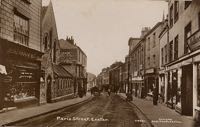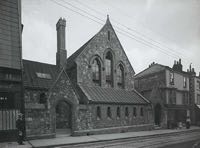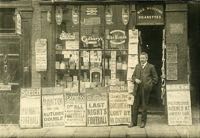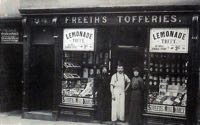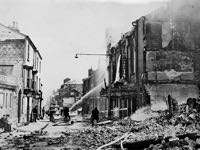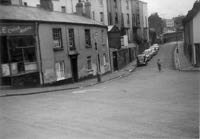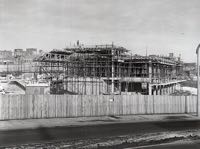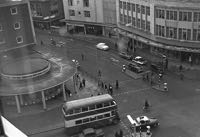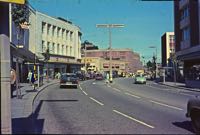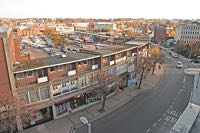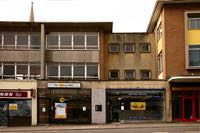
Paris Street
Page updated 25th June 2016
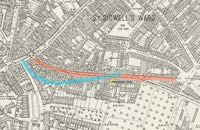 Paris (also spelt Parrys in 1765) Street was
formerly called Shytebrook Street, after the brook of that name that
ran from Chute Street in Newtown to the Exe. It gained its present name
after pearr or pareis
(Old French), both of which mean an enclosure. Before the blitz of
1942, the top of Paris Street was located about 60 metres to the east,
along Sidwell Street. The bottom of the
street joined the Heavitree Road at the Triangle, slightly below the
Pyramids swimming pool. It was a very narrow street that was full of
small shops and businesses including the
first Greenslades garage, which was roughly where the Civic Centre is
positioned now.
Paris (also spelt Parrys in 1765) Street was
formerly called Shytebrook Street, after the brook of that name that
ran from Chute Street in Newtown to the Exe. It gained its present name
after pearr or pareis
(Old French), both of which mean an enclosure. Before the blitz of
1942, the top of Paris Street was located about 60 metres to the east,
along Sidwell Street. The bottom of the
street joined the Heavitree Road at the Triangle, slightly below the
Pyramids swimming pool. It was a very narrow street that was full of
small shops and businesses including the
first Greenslades garage, which was roughly where the Civic Centre is
positioned now.
The street was subject to an accident, whenon 11th January 1653, the Rev John Bettison and his wife were returning from St Mary's Clist on a fine horse. When progressing up Paris Street, they suddenly fell into an old well of some 40 ft in depth which was not covered properly. Locals soon hauled them out of the well unhurt, but the horse was badly bruised and died.(1)
Richard Izacke, the 17th Century Exeter historian referred to the poor road surface for in 1663: 'Parys street with out the Eastgate of this City being much decayed, was well repaired and paved, which was as necessary and as comendable a Worke as hath been done of late years'.
Exeter gained a reputation for destructive fires in the 19th-century culminating in the Theatre Royal fire of 1887. During the 16th-century, most of the buildings in Paris Street were thatched, causing a fire risk. Penalties were severe for those who endured a fire with a fine of 20s (£1,000 today). Paris Street suffered a bad fire in 1837 which the Times reported thus:
THE TIMES
Friday May 19 1837
On Wednesday night, about 10 o’clock, a very
extensive fire broke out in Paris-street, Exeter. It commenced in the
premises of Mr. Hooper, a builder. The fire
burnt rapidly, and soon extended to Silver-place, where six or seven
houses were in a short time entirely destroyed; and the remaining
houses in that place were on fire. In all,
about nine houses had been destroyed, and others were involved in
flames at the time our informant left Exeter, which was past 12
o’clock on Wednesday evening. The fire was
also continuing its ravages along Paris-street.
Mr Hooper's building firm was responsible, in 1835, for building one of the two large warehouses on the quay, and developing much of St Leonards Road.
In September 1912 the Queen's Hall, Paris Street, was the third cinema to open in Exeter. It was later renamed the Palladium Cinema. It continued its performances up until the Second World War when it closed and 'taken over for national purposes'. The end for what had once been Exeter's finest film palace was the night of the 4 May 1942, when it was badly damaged by fire during the blitz.
When Paris Street was rebuilt, after the war, the top was aligned with New North Road and the bottom terminated at the new roundabout that formed part of the inner by-pass. The only remaining building from the pre-war Paris Street is the Honiton Inn, which is the last building on the right before you reach the roundabout. The bus station was moved from Paul Street to Paris Street in 1964.
The redevelopment of Princesshay reached as far as Paris Street. All the buildings above the Southernhay corner on the west side to the corner of the High Street were demolished and replaced with more retail outlets. The bus station is to be redeveloped (2017) and the area will contain yet more retail outlets, a multi screen cinema, and a swimming pool.
The only building left in the street after the bombing of 1942 was the Honiton Inn. After the war, Major Frank Robertson took on the license which he held until his death in 1974. His widow Bette purchased the pub from the brewery, in the same year as her husband died, and continued to run the house until her own death in 2008. It is to be demolished (2017) and replaced with student flats.
World War One Dead - Paris Street
Serjeant, Wilfred
Bagwell, Devonshire Regiment. 21 December 1914. Age 29. Higher
Brunswick Place
Private, John Phillip Barker, Wiltshire Regiment. 26
September 1915. Age 36. Paris St
Private, Albert Anthony Braddon,
Devonshire Regiment, 31 December 1916. Age 25. Morgon's Square
Private,
E Bradford, Devonshire Regiment. 30 November 1914. Age 26. Ida
Cottages, Paris St
Private, W H Chambers, Worcestershire Regiment.
28 July 1916. Age 21. Paris St
Private, John William Chatfield,
Devonshire Regiment. 25 September 1915. Age 28. Cumberland Terrace
Private,
James Henry H Coulman, Devonshire Regiment. 26 October 1917. Age 29.
parents Paris St
Able Seaman, George Frederick Hill, H.M.S.
"Marmion.", Royal Navy. 21 October 1917. Age 23. Silver Place
Sapper,
C Hill, Royal Engineers. 10 February 1917. Jackson's Court
Captain,
Charles Frederic Anderson A Hooper, Wiltshire Regiment. 11 November
1918. Age 46. parents Paris St.,
Private, Arthur Kenwood, Devonshire
Regiment. 7 February 1917. Age 19. Cumberland Terrace
William Lewis,
Royal Engineers. 27 April 1915. Age 39. Silver Place
Sapper, Henry
Wallace Mardon, Royal Engineers. 25 October 1917. Age 25. Paris St
Serjeant
Major, William John McCann, Royal Field Artillery. 13 September 1919.
Age 45. Ebenezer Place
Leading Stoker, William Phare, H.M.S.
"Defence.", Royal Navy. 31 May 1916. Age 24. Morgan Square
Private,
William Henry Pyle, Devonshire Regiment. 2 September 1918. Age 29. 5,
Ebenezer Place
Private, Henry Thomas Simmonds, Middlesex Regiment.
29 October 1918. Age 39. Paris St
Private, Frederick John Spettigue,
Royal Field Artillery, 21 September 1917. Age 19. Paris St
Private,
Herbert Francis Taylor, Royal Scots. 31 December 1917. Age 40. Ebenezer
Place
Serjeant, Edward Almarus Wathen, 7th Dragoon Guards (Princess
Royal's). 30 November 1914. Paris St
WHITE,
Captain, George, South
Staffordshire Regiment. 1 July 1916. Age 29. Paris St
Sources - Greenslades history on their website, Two Thousand Years in Exeter by W G Hoskins, the Times and Izacke's History of Exeter. (1) A concise account of the city of Exeter by Shirley Woolmer 1821.
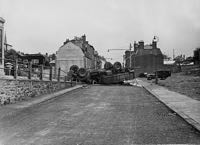
A lorry carrying former Royal Maribe POWs overturned at the junction of Heavitree Road and Paris Street in June 1945. The 21 year old driver was killed.
│ Top of Page │
